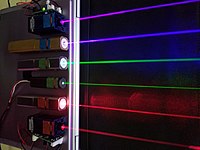
Photo from wikipedia
Zirconia has been regarded as a promising material for dental implants, and Nd:YAG laser treatment has been proposed as a potential strategy to improve its bioactivity. The main aim of… Click to show full abstract
Zirconia has been regarded as a promising material for dental implants, and Nd:YAG laser treatment has been proposed as a potential strategy to improve its bioactivity. The main aim of the present study was to evaluate the in vitro behavior of human fetal osteoblasts in contact with laser-textured zirconia implant surfaces assessing the effect of different texture patterns, spacing between laser passes and number of laser passes. Zirconia discs were produced and treated with Nd:YAG laser according to test group variables: texture (microgrooves and micropillar array), distance between surface features (25 μm, 30 μm and 35 μm), and laser passes [1, 2, 4, and 8]. Untextured sandblasted and acid-etched zirconia discs (SBAE) were used as controls. Human osteoblasts (hFOB 1.19) were cultured for 14 days on test and control samples. Morphology and cellular adhesion were observed using scanning electron microscopy (SEM). Cell viability and proliferation were evaluated at 1, 3, 7, and 14 days using a commercial resazurin-based method. Collagen type I was evaluated at 3 days using ELISA. Alkaline phosphatase (ALP) activity was evaluated at 7 days using a colorimetric enzymatic technique. Group comparisons were tested using ANOVA or Mann-Whitney test (Tukey’s post hoc) using statistical software, and significance was set at p < 0.05. Cell viability and proliferation increased over time for all groups with statistically higher values for laser-textured groups when compared with control at 7 and 14 days in culture ( p < 0.05). Collagen type I levels were higher for study groups ( p < 0.05) when compared with control group. No statistically differences were detected for ALP activity levels between texture and control groups ( p > 0.05). The results suggest that laser-machined zirconia implant surfaces may benefit biological osteoblast response. However, the type of texture, spacing at the range of 25–35 μm, and number of laser passes did not seem to be relevant variables.
Journal Title: Lasers in Medical Science
Year Published: 2020
Link to full text (if available)
Share on Social Media: Sign Up to like & get
recommendations!